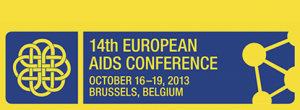Dolutegravir superior to darunavir/r at week 48 in open label treatment naïve study
1 December 2013. Related: Conference reports, Antiretrovirals, EACS 14 Brussels 2013.
 Simon Collins, HIV i-Base
Simon Collins, HIV i-Base
A subgroup analysis from the phase 3 FLAMINGO study was presented by Bonaventura Clotet. [1]
This was a randomised open label study (n=242 in each arm) comparing once-daily dolutegravir to once-daily darunavir/ritonavir (800 mg/100 mg) plus investigator-selected choice of abacavir/3TC or tenofovir/FTC. Patients were stratified by baseline viral load >100,000 copies/mL and choice of background nucleosides. The primary endpoint was viral suppression < 50 copies/mL at week 48 by snapshot algorithm, with follow-up to 96 weeks. this was a non-inferiority study with –12% lower margin. The main analysis from this study was reported a few weeks earlier at the 54th ICAAC in Denver. [2]
Baseline characteristics included approximate median CD4 and viral load of 400 cells/mm3 (with 10% starting <200 cells/mm3) and 4.5 log copies/mL (with 25% starting >100,000 copies/mL), respectively. Median age was 34 years, 15% were women and a third used abacavir/3TC. As with previous ViiV presentations, baseline data was not presented for either IQR or range for median values.
At week 48, viral suppression was reported for 90% vs 83% of people in the dolutegravir vs darunavir/r arms respectively, finding doultegravir to be statistically superior [difference: +7.1% (95%CI: 0.9, 13.2) p=0.02].
Only one patient in each arm had virological failure. Fewer patients discontinued dolutegravir for side effects or other reasons (4% vs 10%), though rates were generally low in both groups. Dolutegravir was also superior in patients with high baseline viral load, with no significant difference by background NRTI, CD4 count, sex or race. CD4 increases were +210 cells/mm3 in each arm.
Two patients in each arm had protocol defined viral failure (to >200 copies/mL), none with drug resistance. Both arms were well tolerated with slightly fewer drug-related discontinuations in the dolutegravir group (2% vs 4%), with similar rates of events across subgroups.
Grade 3/4 laboratory results included elevated creatine kinase (0.10 -0.18 mg/dL) in 7% of dolutegravir vs 4% darunavir patients. Median change in fasting LDL was lower in the dolutegravir compared to darunavir/r arms (+3.1 vs +14.1 mg/dL).
References:
- Clotet B et al. Once-daily dolutegravir versus darunavir/ritonavir in antiretroviral naive subjects: 48 week subgroup analyses from FLAMINGO. 14th EACS, 2013, Brussels. Oral late breaker abstract LBPS4/6.
http://www.eacsmobile.org/libraryEntry/show/30699186861266307 - Feinberg J et al. Once-daily dolutegravir is superior to darunavir/ritonavir in antiretroviral naive adults: 48 week results from FLAMINGO (ING114915). 53rd ICAAC. 10-13 September, 2013, Denver. Abstract H-1464a. See HTB report:
https://i-base.info/htb/23855

